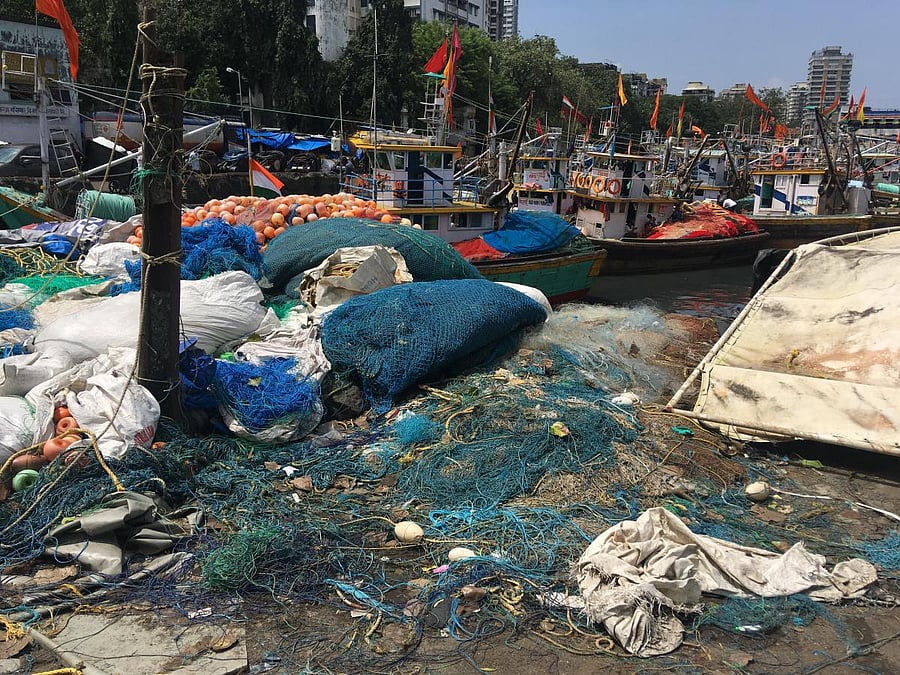Swimming off Marine Drive for the Triathlon in the National Games, a swimmer got caught in a ‘ghost net’ which was floating in the area of the sea in which he was swimming. He was lucky to have been able to free himself and make it to the shore without mishap.
Ghost nets or discarded fishing nets in the ocean cause a massive problem to marine life as well as humans. Independent Film-maker Akansha Tiwari (22) says, “We are currently working on a film called ‘Tangled Seas’ that talks about a very important issue of discarded fishing nets that constitute over 46% of marine litter in the pacific garbage patch alone and kills an estimated 6.5 lakh marine animals every year according to studies. We are a group of enthusiastic and hard-working young people, who care about the ocean and marine life.” They have been filming around Pondicherry, Goa, Chennai and Mumbai besides Malvan and Sindhudurg and are supported by crowdfunding.
There are primarily three kinds of nets based on fishing techniques used in Indian waters explained Akansha. Gill nets which are a wall of netting that hangs in the water. Gillnets are generally used by small-time fishermen who look for crabs and lobsters and shrimp in the shallow waters. They generally have low environmental impact with minimal seabed interaction. The size of fish caught can be determined by the mesh size, helping to avoid catching juvenile fish. While particular species of fish can be targeted by area, gillnets do carry the risk of bycatch (accidental capture of unwanted species) and interaction with other marine animals.
Trawl nets or midwater trawls have a cone-shaped body and a closed ‘cod-end’ that holds their catch.
Pelagic trawls are generally much larger than bottom trawls and can be towed by one or two boats. They are designed to target fish in the surface and mid-level water, such as herring and mackerel. Acoustic technology is used to locate the position and depth of the target fish and the path of the boat and trawls are adjusted accordingly.
Purse Seine nets are used in the deep sea to target dense schools of single-species fish like tuna and mackerel. A vertical net ‘curtain’ is used to surround the school of fish. The bottom of the net is then drawn together to enclose the fish—like tightening the cords of a drawstring purse.
All these nets either break off or get cut by the fishermen when their accidental bycatch contains a protected marine animal. Turtles, whale sharks are some of the marine creatures which the fishermen can get heavily fined for catching since they are listed under Schedule 1 under the Wildlife Protection Act. One of the easiest ways is to get out of a sticky situation is to slit the net and release the creature.
There is also a reward by government departments and NGOs in some parts of the country for releasing these animals in case they are accidentally caught in the nets. This encourages fishermen to save the animal, however, most times they might need to get the animal to the shore in order to be able to document the release which may or may not cause inconvenience to the concerned marine animal.
Nets are not supposed to be on the beach, says Tiwari. They are made of materials similar to plastic. The problem is huge and annually over 6.5 lakh marine animals lose their lives due to starvation, injury and suffocation to this plastic waste and nets alone which catch even non-target species, since the nets continue to fish even as broken parts once they are submerged into the sea. The only people who can locate and clear these nets are divers, but since they can dive only for 45 minutes at a time, all they can do is cut the nets into smaller bits before rising up.
Carrying larger pieces becomes very heavy for them, as almost all the cleanups do not have as many divers as you’d like since these initiatives require funds and are on a voluntary basis. There should be more options available to get these nets out. Geo Tagging each net could be a viable option along with creating a market for the nets to be recycled once they have been brought out of the sea
“Tangled Seas” is a 30-minute Documentary that Akansha has directed. One can check them out and support their film on Instagram at @tangled.seas or their website tangledseas.com
